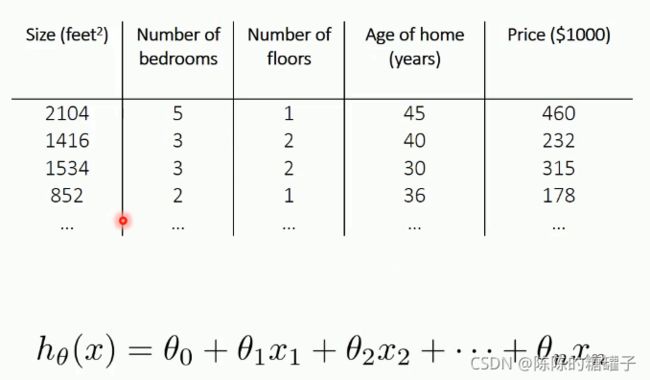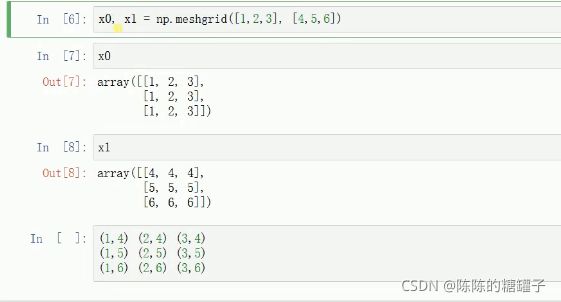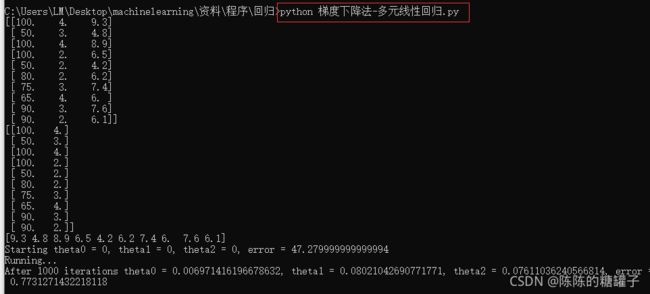多元线性回归&梯度下降法——多元线性回归
多特征

当Y值的影响因素不是唯一时,采用多元线性回归模型


例子

梯度下降法——多元线性回归
import numpy as np
from numpy import genfromtxt
import matplotlib.pyplot as plt
from mpl_toolkits.mplot3d import Axes3D
# 读入数据
data = genfromtxt(r"Delivery.csv",delimiter=',')
print(data)
# 切分数据
x_data = data[:,:-1]#取所有的行,从第一个列开始取到最后一个列,但不包括最后一个列
y_data = data[:,-1]#取所有的行,取最后一列
print(x_data)
print(y_data)
# 学习率learning rate
lr = 0.0001
# 参数
theta0 = 0
theta1 = 0
theta2 = 0
# 最大迭代次数
epochs = 1000
# 最小二乘法
def compute_error(theta0, theta1, theta2, x_data, y_data):
totalError = 0
for i in range(0, len(x_data)):
totalError += (y_data[i] - (theta1 * x_data[i,0] + theta2*x_data[i,1] + theta0)) ** 2
return totalError / float(len(x_data))
def gradient_descent_runner(x_data, y_data, theta0, theta1, theta2, lr, epochs):
# 计算总数据量
m = float(len(x_data))
# 循环epochs次
for i in range(epochs):
theta0_grad = 0
theta1_grad = 0
theta2_grad = 0
# 计算梯度的总和再求平均
for j in range(0, len(x_data)):
theta0_grad += (1/m) * ((theta1 * x_data[j,0] + theta2*x_data[j,1] + theta0) - y_data[j])
theta1_grad += (1/m) * x_data[j,0] * ((theta1 * x_data[j,0] + theta2*x_data[j,1] + theta0) - y_data[j])
theta2_grad += (1/m) * x_data[j,1] * ((theta1 * x_data[j,0] + theta2*x_data[j,1] + theta0) - y_data[j])
# 更新b和k
theta0 = theta0 - (lr*theta0_grad)
theta1 = theta1 - (lr*theta1_grad)
theta2 = theta2 - (lr*theta2_grad)
return theta0, theta1, theta2
print("Starting theta0 = {0}, theta1 = {1}, theta2 = {2}, error = {3}".
format(theta0, theta1, theta2, compute_error(theta0, theta1, theta2, x_data, y_data)))
print("Running...")
theta0, theta1, theta2 = gradient_descent_runner(x_data, y_data, theta0, theta1, theta2, lr, epochs)
print("After {0} iterations theta0 = {1}, theta1 = {2}, theta2 = {3}, error = {4}".
format(epochs, theta0, theta1, theta2, compute_error(theta0, theta1, theta2, x_data, y_data)))
ax = plt.figure().add_subplot(111, projection = '3d') #画3D图
ax.scatter(x_data[:,0], x_data[:,1], y_data, c = 'r', marker = 'o', s = 100)
#点为红色圆形 , marker = 'o'指的是画的点的格式,s是指点的大小
x0 = x_data[:,0]
x1 = x_data[:,1]
# 生成网格矩阵
x0, x1 = np.meshgrid(x0, x1)
z = theta0 + x0*theta1 + x1*theta2
# 画3D图
ax.plot_surface(x0, x1, z)
#设置坐标轴
ax.set_xlabel('Miles')
ax.set_ylabel('Num of Deliveries')
ax.set_zlabel('Time')
#显示图像
plt.show()
其中x0, x1 = np.meshgrid(x0, x1)的作用便是将x0,x1每个坐标对应形成网格


如果想看到比较完整可以转动的图,将代码文件存成.py文件,然后在cmd相应文件内运行







